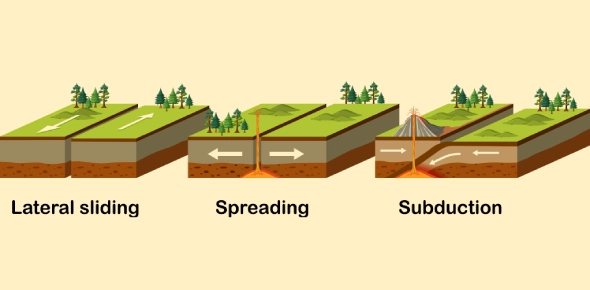Tectonic Plates: Types, Locations, and Functions in Earth's Structure
Lesson Overview
Earthquakes, volcanic eruptions, and the drifting of continents often seem sudden and unpredictable-but they all stem from the same underlying process: tectonic plate movement. In this tectonic plates lesson, you'll explore their functions, types, and global locations to understand how these giant slabs of Earth's crust shape our dynamic planet.
What Are Tectonic Plates?
Tectonic plates are large, rigid sections of Earth's lithosphere, the solid outer layer of the planet. These plates float on the semi-fluid asthenosphere beneath them, allowing them to move slowly over time. The movement and interaction of these plates are key components of the theory of plate tectonics, which explains how Earth's surface is shaped. This movement leads to the formation of mountains, and ocean basins, and causes dynamic events like earthquakes and volcanic eruptions. Major tectonic plates include the Pacific Plate, North American Plate, and Eurasian Plate, among others, each playing a vital role in Earth's geological processes.
Where Are Tectonic Plates Located?
Tectonic plates are situated at the boundaries where different geological features meet, such as mountain ranges, ocean trenches, and mid-ocean ridges. These boundaries are dynamic zones where the plates interact, leading to significant geological activity.
For example, the boundary between the Pacific Plate and the North American Plate along the west coast of the United States is a region of frequent earthquakes and volcanic activity, known as the Ring of Fire. The interaction of these tectonic plates is responsible for the formation of many of Earth's most dramatic geological features and natural disasters, such as earthquakes and volcanic eruptions, making the study of tectonic plates critical for understanding the Earth's geological processes.
Take These Quizzes
What Are the Types of Tectonic Plates?
Tectonic plates are massive segments of Earth's lithosphere that move over the semi-fluid asthenosphere beneath them. They are classified into two primary types based on the crustal material they contain and their relative size: continental plates and oceanic plates. Each type plays a vital role in shaping Earth's surface and driving geological activity.
Continental Plates
Definition:
Continental plates consist mainly of continental crust, which is thick, less dense, and composed largely of granitic rocks.
Characteristics:
- Thickness: ~30–70 km
- Density: ~2.7 g/cm³ (lower than oceanic crust)
- Composition: Mostly granite and other silicate-rich rocks
- Buoyancy: More buoyant, so they rise higher above the mantle
- Age: Generally older (up to billions of years)
Examples:
- Eurasian Plate
- North American Plate
- African Plate
- South American Plate
Oceanic Plates
Definition:
Oceanic plates are made mostly of oceanic crust, which is thinner, denser, and primarily composed of basaltic rocks.
Characteristics:
- Thickness: ~5–10 km
- Density: ~3.0 g/cm³ (more than continental crust)
- Composition: Mainly basalt and gabbro
- Buoyancy: Less buoyant, so they sit lower in the mantle and form ocean basins
- Age: Younger (typically less than 200 million years)
Examples:
- Pacific Plate
- Nazca Plate
- Cocos Plate

Take These Quizzes
What Are the Functions of Tectonic Plates?
Tectonic plates serve as the dynamic foundation of Earth's surface, driving the movement and interaction of the planet's outer shell. Their movement is responsible for shaping continents, forming mountains, creating ocean basins, and generating geological events like earthquakes and volcanic eruptions. Below are the key functions of tectonic plates:
1. Drive Plate Tectonics and Crustal Movement
Tectonic plates are the core elements in the theory of plate tectonics, which explains how the Earth's surface changes over time. As these rigid plates float on the semi-fluid asthenosphere, their motion causes continental drift, seafloor spreading, and the slow reshaping of Earth's surface.
2. Form Major Landforms and Ocean Basins
Through collision, separation, or sliding past one another, tectonic plates create:
- Mountains (e.g., Himalayas from the collision of the Indian and Eurasian Plates)
- Ocean basins (from the divergence of oceanic plates)
- Rift valleys, island arcs, and trenches
These landforms result directly from tectonic interactions at plate boundaries.
3. Cause Earthquakes
When tectonic plates grind, collide, or slip past each other at transform boundaries, fault lines develop. The sudden release of energy from stress accumulation causes earthquakes. Regions near active boundaries-such as the Pacific Ring of Fire-experience frequent seismic activity.
4. Generate Volcanic Activity
Volcanoes often form at:
- Divergent boundaries (e.g., Mid-Atlantic Ridge)
- Convergent boundaries (e.g., subduction zones)
- Hotspots (e.g., Hawaiian Islands)
The movement of tectonic plates allows magma to rise from the mantle to the surface, creating volcanic eruptions and new crust.
5. Recycle Earth's Crust
Tectonic activity plays a role in the rock cycle:
- At divergent boundaries, new crust forms through volcanic activity.
- At convergent boundaries, old crust is subducted back into the mantle and melted.
This recycling process maintains Earth's surface balance over geologic time.
6. Influence Climate and Ocean Currents
Plate movements affect the position of continents, which alters:
- Global ocean currents
- Wind patterns
- Rainfall distribution
Over millions of years, tectonic activity has influenced long-term climate change and the evolution of ecosystems.
7. Support Continental Drift and Supercontinent Cycles
Tectonic plates slowly shift continents across the globe. This explains the breakup of past supercontinents like Pangaea and predicts future configurations. These supercontinent cycles shape biodiversity, sea levels, and global climates.
Conclusion
In this Tectonic Plates lesson, you have explored the foundational principles that govern Earth's dynamic crust. We've covered the classification of tectonic plates, from the dense oceanic plates to the thicker continental plates, and examined how their movements shape our planet's surface. By understanding the interactions at plate boundaries-whether they be divergent, convergent, or transform-you've gained insights into the forces behind earthquakes, volcanic eruptions, and mountain formation.
Rate this lesson:
 Back to top
Back to top


.webp)
(12).webp)